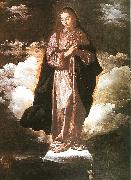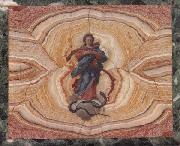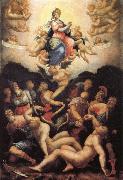
|
Diego Velazquez
|
|||
|
|
|||
| Spanish Baroque Era Painter, 1599-1660 Spanish painter. He was one of the most important European artists of the 17th century, spending his career from 1623 in the service of Philip IV of Spain. His early canvases comprised bodegones and religious paintings, but as a court artist he was largely occupied in executing portraits, while also producing some historical, mythological and further religious works. His painting was deeply affected by the work of Rubens and by Venetian artists, especially Titian, as well as by the experience of two trips (1629-31 and 1649-51) to Italy. Under these joint influences he developed a uniquely personal style characterized by very loose, expressive brushwork. Although he had no immediate followers, he was greatly admired by such later painters as Goya and Manet | |||
|
|
|||
|
The Immaculate Conception Diego Velazquez10.jpg Painting ID:: 740 |
National Gallery, London, England | ||
|
|
|||
|
Giovanni Battista Tiepolo
|
|||
|
|
|||
| Italian Rococo Era Painter, 1696-1770 Giovanni Battista Tiepolo was born in Venice on March 5, 1696. His father, who was part owner of a ship, died when Tiepolo was scarcely a year old, but the family was left in comfortable circumstances. As a youth, he was apprenticed to Gregorio Lazzarini, a mediocre but fashionable painter known for his elaborately theatrical, rather grandiose compositions. Tiepolo soon evolved a more spirited style of his own. By the time he was 20, he had exhibited his work independently, and won plaudits, at an exhibition held at the church of S. Rocco. The next year he became a member of the Fraglia, or painters guild. In 1719 he married Cecilia Guardi, whose brother Francesco was to become famous as a painter of the Venetian scene. They had nine children, among them Giovanni Domenico and Lorenzo Baldassare, who were also painters. In the 1720s Tiepolo carried out many large-scale commissions on the northern Italian mainland. Of these the most important is the cycle of Old Testament scenes done for the patriarch of Aquileia, Daniele Dolfin, in the new Archbishop Palace at Udine. Here Tiepolo abandoned the dark hues that had characterized his early style and turned instead to the bright, sparkling colors that were to make him famous. | |||
|
|
|||
|
The Immaculate Conception Giovanni Battista Tiepolo1.jpg Painting ID:: 1612 |
1767-69 Museo Nacional del Prado, Madrid | ||
|
|
|||
|
unknow artist
|
|||
|
|
|||
|
|
|||
|
The immaculate conception new3/unknow artist-659259.jpg Painting ID:: 27580 |
mk56 oil on alabastro fiorito,set within a verde antico border | ||
|
|
|||
|
Giovanni Battista Tiepolo
|
|||
|
|
|||
| Italian Rococo Era Painter, 1696-1770 Giovanni Battista Tiepolo was born in Venice on March 5, 1696. His father, who was part owner of a ship, died when Tiepolo was scarcely a year old, but the family was left in comfortable circumstances. As a youth, he was apprenticed to Gregorio Lazzarini, a mediocre but fashionable painter known for his elaborately theatrical, rather grandiose compositions. Tiepolo soon evolved a more spirited style of his own. By the time he was 20, he had exhibited his work independently, and won plaudits, at an exhibition held at the church of S. Rocco. The next year he became a member of the Fraglia, or painters guild. In 1719 he married Cecilia Guardi, whose brother Francesco was to become famous as a painter of the Venetian scene. They had nine children, among them Giovanni Domenico and Lorenzo Baldassare, who were also painters. In the 1720s Tiepolo carried out many large-scale commissions on the northern Italian mainland. Of these the most important is the cycle of Old Testament scenes done for the patriarch of Aquileia, Daniele Dolfin, in the new Archbishop Palace at Udine. Here Tiepolo abandoned the dark hues that had characterized his early style and turned instead to the bright, sparkling colors that were to make him famous. | |||
|
|
|||
|
The Immaculate Conception new3/Giovanni Battista Tiepolo-789732.jpg Painting ID:: 28139 |
mk61 1767-1769 Oil on canvas 279x152cm | ||
|
|
|||
|
Giorgio Vasari
|
|||
|
|
|||
| 1511-74 Italian painter, architect, and writer. Though he was a prolific painter in the Mannerist style, he is more highly regarded as an architect (he designed the Uffizi Palace, now the Uffizi Gallery), but even his architecture is overshadowed by his writings. His Lives of the Most Eminent Architects, Painters, and Sculptors (1550) offers biographies of early to late Renaissance artists. His style is eminently readable and his material is well researched, though when facts were scarce he did not hesitate to fill in the gaps. In his view, Giotto had revived the art of true representation after its decline in the early Middle Ages, and succeeding artists had brought that art progressively closer to the perfection achieved by Michelangelo. | |||
|
|
|||
|
The Immaculate Conception new3/Giorgio Vasari-988926.jpg Painting ID:: 29858 |
mk67 Oil on panel 22 13/16x15 3/4in Uffizi,Gallery | ||
|
|
|||
|
Also Buy::. For Following Paintings / Artists / Products, Please Use Our Search Online: |












